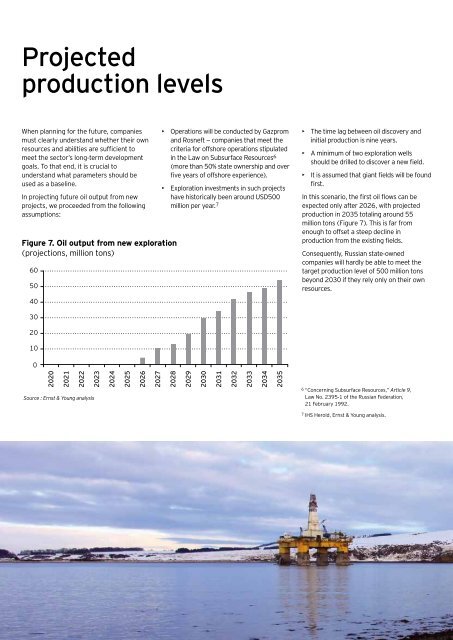The future of Russian oil exploration
The future of Russian oil exploration
The future of Russian oil exploration
Create successful ePaper yourself
Turn your PDF publications into a flip-book with our unique Google optimized e-Paper software.
Projected<br />
production levels<br />
When planning for the <strong>future</strong>, companies<br />
must clearly understand whether their own<br />
resources and abilities are sufficient to<br />
meet the sector’s long-term development<br />
goals. To that end, it is crucial to<br />
understand what parameters should be<br />
used as a baseline.<br />
In projecting <strong>future</strong> <strong>oil</strong> output from new<br />
projects, we proceeded from the following<br />
assumptions:<br />
Figure 7. Oil output from new <strong>exploration</strong><br />
(projections, million tons)<br />
60<br />
50<br />
40<br />
30<br />
20<br />
10<br />
0<br />
2020<br />
2021<br />
2022<br />
Source : Ernst & Young analysis<br />
2023<br />
2024<br />
2025<br />
2026<br />
2027<br />
• Operations will be conducted by Gazprom<br />
and Rosneft — companies that meet the<br />
criteria for <strong>of</strong>fshore operations stipulated<br />
in the Law on Subsurface Resources 6<br />
(more than 50% state ownership and over<br />
five years <strong>of</strong> <strong>of</strong>fshore experience).<br />
• Exploration investments in such projects<br />
have historically been around USD500<br />
million per year. 7<br />
10 <strong>The</strong> <strong>future</strong> <strong>of</strong> <strong>Russian</strong> <strong>oil</strong> <strong>exploration</strong> Beyond 2025<br />
2028<br />
2029<br />
2030<br />
2031<br />
2032<br />
2033<br />
2034<br />
2035<br />
• <strong>The</strong> time lag between <strong>oil</strong> discovery and<br />
initial production is nine years.<br />
• A minimum <strong>of</strong> two <strong>exploration</strong> wells<br />
should be drilled to discover a new field.<br />
• It is assumed that giant fields will be found<br />
first.<br />
In this scenario, the first <strong>oil</strong> flows can be<br />
expected only after 2026, with projected<br />
production in 2035 totaling around 55<br />
million tons (Figure 7). This is far from<br />
enough to <strong>of</strong>fset a steep decline in<br />
production from the existing fields.<br />
Consequently, <strong>Russian</strong> state-owned<br />
companies will hardly be able to meet the<br />
target production level <strong>of</strong> 500 million tons<br />
beyond 2030 if they rely only on their own<br />
resources.<br />
6 “Concerning Subsurface Resources,” Article 9,<br />
Law No. 2395-1 <strong>of</strong> the <strong>Russian</strong> Federation,<br />
21 February 1992.<br />
7 IHS Herold, Ernst & Young analysis.


